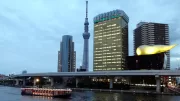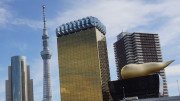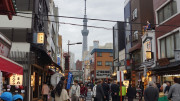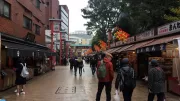Asakusa is located on the northeastern fringe of central Tokyo, at the eastern end of the Ginza subway line. It sits in what is known as the “low city” on the banks of the Sumida River (Sumida-gawa). As one of Tokyo’s oldest districts, Asakusa is rich in history and well worth a visit.
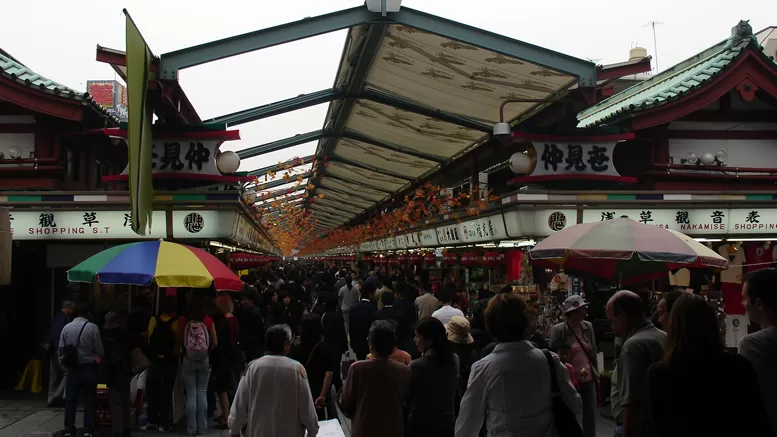
In the early 20th century, Asakusa was Tokyo’s premier entertainment district, filled with bars, clubs, and a thriving nightlife scene. However, much of the area was destroyed during World War II, and in the post-war period, entertainment hubs shifted to Shinjuku, which remains Tokyo’s entertainment capital today.
Despite this shift, Asakusa still retains traces of its entertainment past, with small theatres and numerous pachinko parlours. Some theatres specialise in screening classic Japanese films, often drawing older audiences who come for a nostalgic experience.
One unique attraction in the area is Hanayashiki, a charming retro amusement park near Sensō-ji Temple. Established in 1853, it is Japan’s oldest amusement park, featuring vintage carnival rides that cater more to children but still offer a delightful throwback to a bygone era.
Asakusa’s Geisha & Lodging
Asakusa is also home to Tokyo’s oldest geisha district, with around 45 working geisha still performing in the area. While far smaller than Kyoto’s geisha community, Asakusa offers a glimpse into this traditional art form.
For budget-conscious travellers, Asakusa is one of Tokyo’s more affordable areas to stay, with many ryokan (traditional inns) and small hotels offering great value compared to more commercialised parts of the city.
Sensō-ji Temple & Nakamise Street
Sensō-ji Temple, Asakusa’s most famous landmark, is Tokyo’s oldest and most visited temple. Every day, worshippers and tourists flock to the temple grounds, passing through Kaminarimon (Thunder Gate) and walking along Nakamise Street, a bustling shopping street lined with souvenir stalls and traditional snack vendors.
While Sensō-ji is the main attraction, many visitors miss out on Asakusa’s other hidden gems. There is more than enough to see and do in Asakusa for a full-day itinerary, but even a half-day visit allows you to experience many of its highlights.
Modern Asakusa & the Sumida River
The Sumida River waterfront is a striking contrast to Asakusa’s old-world charm, featuring modern architecture and scenic riverside walks. A standout landmark is the Asahi Beer Headquarters, famous for its golden “Flame d’Or” sculpture, which has been nicknamed the “Golden Turd” due to its unusual shape. Though the building itself isn’t open to the public, it makes for a great photo opportunity—especially from the boats that operate on the river.
For kitchenware enthusiasts, Kappabashi-dōri (Kappabashi Kitchen Town) is a must-visit. This street is lined with shops selling everything kitchen-related, from professional-grade knives and cookware to affordable Japanese ceramics. One of its biggest attractions is the incredible plastic food replicas used by restaurants for display. These hyper-realistic food models make for a quirky souvenir, though they can be quite pricey. Look out for the giant chef’s head atop one of the buildings marking the start of Kappabashi-dōri.
Tokyo Skytree
One of the most significant additions to Asakusa’s skyline is the Tokyo Skytree, which opened in 2012. At 634 metres, it is the tallest structure in Japan and one of the tallest towers in the world. The Skytree serves as a broadcasting tower but is also a major tourist attraction, featuring two observation decks with panoramic views of Tokyo. The Tokyo Solamachi shopping complex at its base houses shops, restaurants, and even an aquarium.
Asakusa Culture Tourist Information Center
For travellers exploring the area, the Asakusa Culture Tourist Information Center is an excellent starting point. Conveniently located opposite Kaminarimon, this modern facility offers maps, travel advice, and multilingual support. The highlight is its free observation deck on the 8th floor, which provides spectacular views of Sensō-ji, the Sumida River, and Tokyo Skytree.
Getting to Asakusa
Asakusa is easily accessible via public transport:
Ginza Line: Take the Tokyo Metro Ginza Line to Asakusa Station (last stop).
Toei Asakusa Line: Provides direct access from Narita and Haneda Airports.
Tawaramachi Station (also on the Ginza Line) is within walking distance and offers a great way to explore Asakusa on foot.
If arriving via the JR Yamanote Line, transfer at Ueno, Kanda, or Shimbashi to connect to the Ginza Line.

